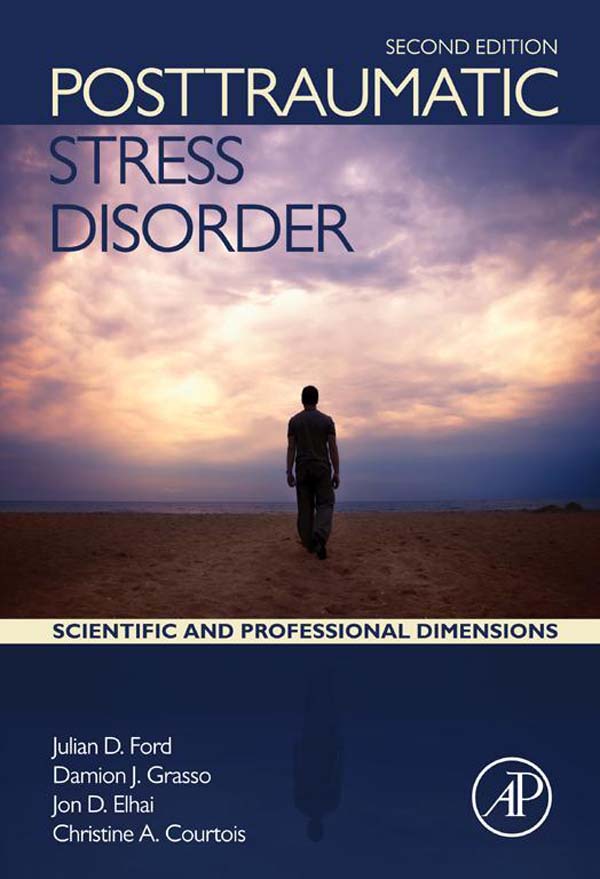Table of Contents
List of illustrations
- Figures in 1
- Figures in 2
- Figures in 3
- Figures in 4
- Figures in 5
- Figures in 7
- Figures in 9
- Figures in 11
- Figures in 12
Landmarks
Table of Contents
Posttraumatic Stress Disorder
Scientific and Professional Dimensions
Second Edition
Julian D. Ford
Department of Psychiatry, University of Connecticut Health Center, Farmington, USA
Damion J. Grasso
Department of Psychiatry, University of Connecticut Health Center, Farmington, USA
Jon D. Elhai
Department of Psychology and Psychiatry, University of Toledo, Ohio, USA
Christine A. Courtois
Independent Practice, Washington, USA
National Clinical Trauma Consultant, Elements Behavioral Health, LLC, CA, USA

Copyright
Academic Press is an imprint of Elsevier
525 B Street, Suite 1800, San Diego, CA 92101-4495, USA
The Boulevard, Langford Lane, Kidlington, Oxford OX5 1GB, UK
First Edition 2009
Second Edition 2015
Copyright 2015, 2009 Elsevier Inc. All rights reserved.
No part of this publication may be reproduced or transmitted in any form or by any means, electronic or mechanical, including photocopying, recording, or any information storage and retrieval system, without permission in writing from the publisher. Details on how to seek permission, further information about the Publishers permissions policies and our arrangements with organizations such as the Copyright Clearance Center and the Copyright Licensing Agency, can be found at our website: www.elsevier.com/permissions.
This book and the individual contributions contained in it are protected under copyright by the Publisher (other than as may be noted herein).
Notices
Knowledge and best practice in this field are constantly changing. As new research and experience broaden our understanding, changes in research methods, professional practices, or medical treatment may become necessary.
Practitioners and researchers must always rely on their own experience and knowledge in evaluating and using any information, methods, compounds, or experiments described herein. In using such information or methods they should be mindful of their own safety and the safety of others, including parties for whom they have a professional responsibility.
To the fullest extent of the law, neither the Publisher nor the authors, contributors, or editors, assume any liability for any injury and/or damage to persons or property as a matter of products liability, negligence or otherwise, or from any use or operation of any methods, products, instructions, or ideas contained in the material herein.
ISBN: 978-0-12-801288-8
British Library Cataloguing-in-Publication Data
A catalogue record for this book is available from the British Library
Library of Congress Cataloging-in-Publication Data
A catalog record for this book is available from the Library of Congress
For information on all Academic Press publications visit our website at http://store.elsevier.com/
Typeset by MPS Limited, Chennai, India www.adi-mps.com
Printed and bound in the United States

Preface
The published literature on posttraumatic stress disorder (PTSD) has grown rapidly over the past 25 years, almost doubling in size since the 2009 first edition of this book. Now there are more than 10,000 journal articles and hundreds of books on this topic that are widely read by scientists, clinicians, educators, trainees, and laypersonsand increasingly by policy makers, judges and attorneys, organizational leaders, and opinion leaders in the media and popular and political culture. PTSD offers a widely accepted framework for understanding the effects of experiencing potentially traumatic events such as terrorism, domestic and community violence, physical and sexual assault, child maltreatment, human trafficking, refugee adversity homicide, disaster, life-threatening illness and accidents, torture, genocide, and the injury done to both civilians and military combatants in war. Public as well as professional awareness has grown commensurately as most people now recognize the profound impact of psychological trauma and the need for proactive and scientifically based approaches to timely prevention, humanitarian relief, and evidence-based treatment for traumatized persons, communities, and nations.
As a result, scholars, researchers, and educators in the social, biological, medical, political, and behavioral sciences need a current and comprehensive source on PTSD for their studies and teaching. The Handbook of PTSD, Second Edition () provide snapshots of key issues and topics in the PTSD field, but practitioners, clinicians, students, and trainees in the health care and human and social services need a concise and complete overview of PTSD as their source of authoritative information on PTSD. This Second Edition of Posttraumatic Stress Disorder: Science and Practices was designed to meet that need for a comprehensive yet concise textbook on PTSD that will be useful to researchers, educators, clinicians, and trainees in graduate and advanced undergraduate courses in the mental health, health care, social and human services, and criminal justice fields.
This text covers all major topics in the traumatic stress field, from etiology to neurobiology to assessment and diagnosis to evidence-based treatment and prevention. All topics covered in the two comprehensive Encyclopedias on PTSD () of the critical role that ethnicity, culture, gender and sexual identity, and legal and economic factors have in influencing PTSD and its assessment, treatment, and prevention; and (vi) a developmental focus on the nature of PTSD across the life span from infancy to older adulthood.
The book is written at the level suitable for both advanced undergraduate and graduate trainees, as well as for educators, clinicians, or researchers seeking an overview of the traumatic stress field. The text uses language that is free of technical jargon except for key terms that are supplemented with nontechnical definitions and examples. The focus is on describing state-of-the-art research and clinical methodologies in down-to-earth terms with interesting examples and both research and clinical case studies. The text introduces the major issues, controversies, and findings in the field, as well as highlights what is not yet known and how researchers and clinicians are (or can) make further discoveries.
, Understanding Psychological Trauma and Posttraumatic Stress Disorder (PTSD), describes the history of scientific knowledge and popular conceptions of psychological trauma from the earliest writings several thousand years ago to modern definitions and diagnoses. Controversies such as the nature and validity of memories of childhood traumatic exposure, potential bias in diagnosis and treatment of females and persons of color, gender and ethnocultural differences in the experience and impact of psychological trauma, major expansion in the fields understanding of the range of problems involved in PTSD and diagnostic definitions of PTSD in the United States (the 2014











